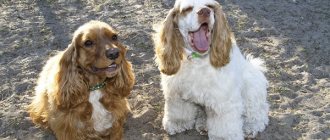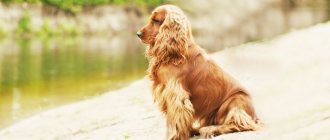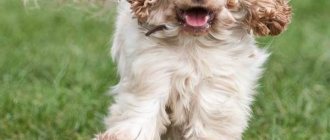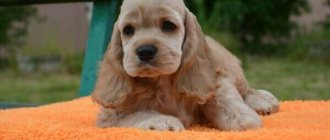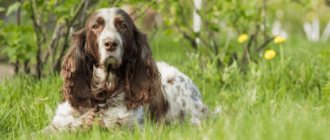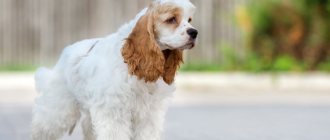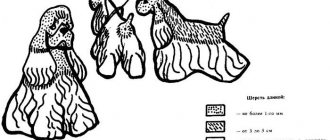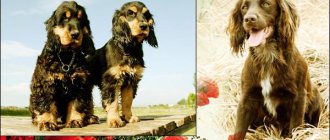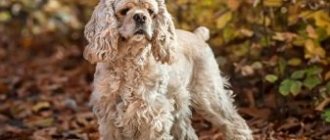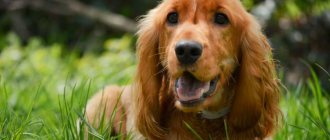Walk
The English Cocker Spaniel, like its American counterpart, loves long walks and is happy to run in any weather.
An adult cocker needs to be walked twice a day for one and a half to two hours.
But you shouldn’t be outside in rainy weather for more than half an hour. For walking you will need a long leash with a tape measure. You cannot let the dog go: a cocker can chase a cat, following its hunting instincts, and the screams of its owner will not stop it. Closed areas or enclosures are suitable for free walking.
A cocker must get used to a leash from childhood. The collar for the puppy is selected so that two fingers fit between it and the baby’s neck. As it grows it changes to a larger size. A cocker collar should be wide, light and soft. Products made from textiles or soft leather are suitable. Harnesses are contraindicated for a dog of this breed.
The puppy may get tired while walking. Nothing bad will happen if the owner picks him up and carries him for some distance.
By the age of six months, cockers develop joints and skeletal bones. They are not allowed to go up and down stairs, jump over barriers or jump from heights.
It is important to remember that walking your dog in public places is only allowed with a muzzle and a short leash.
Description of the breed
The official description of the breed has not changed since 1966. The parameters of the Russian hunting spaniel (sometimes called the dwarf Russian spaniel) are as follows:
- weight – 10-18 kg;
- height – 40-45 cm;
- the head is proportional to the body and other parts of the body;
- nose black, wide, slightly flattened;
- the teeth are white, located close to each other;
- the ears are long, drooping, soft, pleasant to the touch;
- rectangular body;
- the chest is elongated, the ribs are well defined;
- paws are strong, with powerful joints;
- the tail is movable, in line with the spine;
- the coat is long, straight, shiny, especially long, silky coat on the neck, ears, paws, and pants.
The sizes of most body parts are proportional to each other. An outstanding feature is the wide ears, which catch the eye when you first look at the dog. They develop especially impressively in the wind. Despite their larger size, they are quite lightweight.
Color
The colors established by the standard are varied, therefore, scrolling through the images of representatives of the breed, you can see a huge number of colors. All of them are divided into three groups:
- Single-color: black, chocolate, red, red (all shades). Small-sized spots of light colors are acceptable. Most often they are located on the paws and neck.
- Two-color. The main shade is white; there are spots in different parts of the body, occupying more than 25% of the total color. Common shades among them are brown, red, black. Often there are hairs containing several colors.
- Tricolor. The same combinations of shades as two-tone ones are acceptable; there is a tan that matches the overall color.
The most common color of the Russian Hunting Spaniel is chocolate.
Character
The character of the breed changes dramatically as they grow. When a puppy is 1 month old, he is no different from babies of other breeds: playful, cheerful, completely dependent on others. This situation persists for six months; by 7-8 months, the animal’s innate character traits awaken. The recognized characteristics of the breed describe the Russian hunting spaniel as a brave, courageous pet. He is a real hunter, ready to follow his master if he is really engaged in catching wild animals. However, today this activity is not widespread. Endurance, courage, perseverance, an excellent sense of smell, and a lot of energy can be useful in other activities.
Do not think that the Russian hunting spaniel is not suitable for a calm, measured life at home. Proper training of a puppy can develop the traits of a pet. Hunting skills have been developed since childhood; gun-specific character traits can be instilled with the help of proper upbringing.
The Russian Hunting Spaniel is a versatile pet. His flexible character traits make him a teacher in a large family; he can not only tolerate the antics of children, but also play with them and look after them. A sense of responsibility allows older people who lead a measured lifestyle to have representatives of the breed. The Russian Hunting Spaniel has a unique personality that suits most people.
Differences from the Cocker Spaniel
The Cocker Spaniel is the ancestor of the Russian Hunting Spaniel. Externally, these dogs are similar, with slight differences in size and build. The Cocker Spaniel differs from the Russian Spaniel in character, and radically:
| Cocker | Russian hunting |
| Has a decorative purpose, often lazy | Has pronounced working qualities, perseverance, hard work |
| Family oriented | Focused on loyalty to the owner |
| Poor security skills | Strong security skills |
| Stubborn | Easy to learn |
| Long training required before hunting skills develop | Joint hunting with the owner is possible after several months of training |
Feeding
The English Cocker Spaniel, like the American Cocker, is unpretentious in food. He can eat anything. For a dog to live a long and fulfilling life, its diet must be balanced, taking into account activity.
Feeding the puppy
Feeding your Cocker Spaniel at a certain time and in a strictly designated place will help accustom him to routine and order.
Until the age of two months, the baby is fed six times a day. From two to four months, the number of feedings is four to five times. By six months, a grown puppy can be fed three to four times. By the age of ten months, the pet is transferred to two meals a day. And this regime remains constant.
Feeding an adult dog
There is an opinion among some breeders that an adult cocker can be fed once a day. It is worth disproving such a theory. It is better to divide the dog’s diet into two equal portions and feed it in the morning and evening, with an equal time interval. With this scheme, nutrients enter the body evenly.
Cockers are prone to gluttony. Appetite must be controlled.
Training and education
Raising a puppy begins from the first days of its appearance in the house. By the age of six months, the pet must have mastered a set of basic commands well. Particular attention is paid to the direction - to me. The Russian spaniel is a hunter; all breeds with such skills are prone to escape. In order not to run far from the owner, having noticed a cat on the street, the dog must follow this command the first time. You can turn to dog handlers for help in cases where you want to master a specific training program with your pet. Spaniels are easy to train, so you can choose any of them. The main thing is to teach the puppy basic commands so that he has certain knowledge and skills for further study.
First of all, you need to train your pets to respond to nicknames. Popular for spaniel boys are Lucky, Mickey, Rippy, Scotch, for girls - Dolly, Tracy, Jena, Linda.
Bathing
To keep your dog clean, it is not necessary to bathe it every time it gets dirty.
It is enough to brush regularly with a soft brush. If you bathe frequently using detergents, your dog may experience itchy skin and flaking. Shampoo and soap destroy the fat layer, which naturally protects the skin from dirt and moisture. This is especially true for puppies under six months of age. You can bathe your puppy using homemade shampoo, consisting of kefir or curdled milk, egg yolk and warm water. This composition will not damage the protective layer. If the pet is dirty and the dirt cannot be washed off with a home remedy, then shampoo for long-haired dogs is used. It is diluted with warm water in a 1:1 ratio.
Paws and ears are washed every time you return to the house. The puppy must be taught this procedure from an early age.
Cost of a Russian Spaniel
The price of the breed can vary depending on who the sire and dam are. It is quite possible to purchase a puppy of ordinary dogs, bypassing clubs and kennels, for about 500-1000 rubles, but in this case you may encounter scammers.
It is also possible to find a purebred baby of a father and mother who do not have supporting documents; its price will be approximately 5-15 thousand rubles. Puppies from working dogs of the Russian Spaniel breed with test diplomas, purchased from a nursery, will cost about 15-25 thousand rubles.
Grooming
The Cocker's luxurious coat requires careful attention.
Grooming an English Cocker Spaniel is easier than caring for an American Cocker. The Englishman's coat is not as thick as the American's. Therefore, the haircut of an English cocker will be different from that of an American. Otherwise the differences are unnoticeable. How to care for the coat: on your own or with the help of a groomer, depends on the skills of the owner. For a beginner, it is better to go through the first care activities in a salon. Subsequent manipulations can be performed independently, having an idea of proper care.
Grooming includes the following:
- Combing and combing.
- Timely haircut.
- Trimming as needed.
A haircut
Basic standards for cutting a spaniel in a comparative table.
| American Cocker | English cocker | |
| Head | Short shaved hair on the skull and upper neck. The upper third of the ear and cheeks are also shaved, as is part of the muzzle around the eyes. | Short-cropped coat, no bangs. |
| Torso | The fur on the back is cut as short as possible and all undercoat is removed. The upper part of the neck and back is stripped. A machine is used to trim the tail. | In the chest area the fur is cut short; a triangular area above the chest is left untouched; wool is trimmed on the croup; the area around the anus is cut very short in the shape of a quadrangle. |
| Legs | Limbs are not subject to haircuts. Only the paw pads are trimmed. | On the front legs, the hair on the front and sides is cut short, leaving long hair on the back. Hindquarters: The upper thigh remains covered with long hair. From the hock to the paw, the coat is cut as short as possible. |
Combing
The Cocker needs to be brushed daily. After all, not only the appearance of the dog depends on how to care for the coat. When combing, dead hairs are removed, the skin receives a kind of massage, blood circulation improves, and metabolism accelerates.
It is necessary to accustom a dog to a comb from puppyhood, then this procedure will bring pleasure to both the owner and the pet.
Should you cut your hair yourself or leave it to a professional?
You can carry out an incomplete, or, as it is also called, hygienic haircut of a cocker who does not participate in exhibitions, yourself, since this does not require professional skills: you just need to confidently hold scissors and a comb in your hands.
But if the pet is a show pet, then it is better to take it to a groomer or salon, since a non-professional can easily ruin the pet’s fur with a poor-quality haircut, sometimes even irrevocably.
It is also recommended to contact a professional if a grown-up puppy is going to have his hair cut for the first time.
After all, an inept haircut can not only ruin your pet’s fur, but also greatly frighten you during the procedure, which will subsequently complicate his care if the dog begins to be afraid of scissors and hairdressing clippers.
If the owner of a cocker spaniel wants to cut his pet in a special way, choosing an unusual haircut for him, then in this case, of course, you should also contact a professional groomer .
Ear care
Spaniel ears require special care. Long ears are poorly ventilated and are therefore susceptible to fungal diseases and inflammatory processes. It is necessary to clean the ears from wax and dirt once every 2-3 days, using a damp cotton swab. Clean the outer part of the ear canal. You can’t go deep inside - you can damage the cocker’s delicate ear.
In spring and summer, the main problem is ticks. If your pet behaves restlessly, shakes its head, or tries to scratch its ears with its paws, it means there is a tick there.
Daily inspection of the inner and outer parts of the ear is necessary.
Parasites removed in time will not be able to penetrate deep into the ear canal.
The long ears of the Cocker Spaniel collect all debris, especially burrs. If there is a walk in the forest, the dog is given a special cap for the spaniel ears. This will make grooming easier.
Diseases and life expectancy
The average life expectancy is 13-16 years. How long spaniels live largely depends on the presence/absence of proper care for the dogs. The general health indicators of the breed are good; the following ailments may occur:
- otitis;
- allergic reactions (usually to food);
- obesity.
Most possible diseases can be prevented. For example, otitis - by conducting a proper examination of the ears, obesity - by monitoring the diet.
Timely vaccinations are the key to a healthy, full life for your pet.
Dental care
To accustom a puppy to examining and brushing his teeth from an early age, he is taught the “Show your teeth” command. This will come in handy when the dog begins to participate in exhibitions, because a dental examination is a necessary item.
Dental care is carried out regularly once a week, starting from the age of six months, after the complete replacement of milk teeth with permanent ones.
To do this, use a soft toothbrush and toothpaste for dogs to clean the teeth with gentle movements. Soft plaque on teeth can be removed with a cotton swab dipped in water. But tartar in dogs is difficult to remove on your own. To carry out this procedure, contact a veterinarian. The formation of tartar is dangerous because it can cause inflammatory gum disease.
As a natural way to clean the teeth, the spaniel is offered to gnaw on large bones and cartilage. Caring for and maintaining healthy teeth is a prerequisite for maintaining the health of your pet.
Origin story
Spain is considered the country of origin of spaniels; the British are recognized as the creation of the breed itself. In the 18th century, representatives of the breed began to be imported into Russia as gifts to noble people, especially rulers. By this time, in developed countries: Spain, France, England, Germany, the hunting spaniel was widely used for catching waterfowl.
After the end of the Great Patriotic War, the transportation of dogs from different countries began to the territory of the Soviet Union. Representatives of various breeds, including spaniels, were actively transported. By 1951, a standard was developed, the characteristics of the breed were officially recognized, and breeders tried to adhere to them. After 15 years, it was decided to make minor adjustments to it.
Although the birthplace of the breed is Russia, by the beginning of the 20th century, improved representatives of the breed began to conquer the United States and other large countries. The peculiarity of the history of the appearance of the Russian hunting spaniel is that it combines the blood of a huge number of breeds. At first they were imported into Russia; Russian selectors developed an improved breed, which began to spread in the countries where the spaniel’s ancestors came from.
When breeding the breed, the types of dogs whose character was suitable for hunting were used. Some of them swam well, others were fast, agile, and lively, and as a result, they managed to achieve their original goal.
Puppy care
Features of maintenance and care include teaching your four-legged friend the basics of training and education. Classes should be regular, timely, and take place in a playful environment. Caring for and raising a puppy is long and painstaking work. The owner's tolerance and personal contact contribute to rapid success in practicing and consolidating skills.
Toilet training
One of the problems that the owner faces with the appearance of a pet is how to accustom the puppy to fulfill its natural needs. At first, while the cocker is small and there are no scheduled vaccinations, going outside is prohibited. Toilet training a spaniel is not difficult.
Having discovered the area where the dog most often does his dirty deeds, the area is covered with newspapers or a disposable medical diaper. These porous materials will quickly absorb dirt. If you notice that the puppy begins to sniff and behave restlessly, you should take the baby to this place. Not everything will work out the first time; most likely, the puppy will want to run away. At this moment, it is worth being persistent and making sure that he recovers in the right place.
A small cocker will quickly get used to a diaper if you take him to the toilet after eating and sleeping. Be sure to praise the puppy after he has returned to the right place.
A spaniel puppy at the age of 3 months can already go outside for walks. It happens that, having gotten used to the diaper, the dog does not want to recover on the street. In this case, you need to take the soiled newspapers outside, thus making it clear what the cocker should do.
Cockers are quite clean animals. There should be no difficulties in toilet training a spaniel. An exception may be an emotionally unbalanced dog. He is able to urinate out of fear or out of joy. In this case, you need to contact a veterinarian. Perhaps it is worth reconsidering the owner’s attitude towards the dog: if abused, the dog can do its dirty deeds to spite the person.
Leash training
Another significant point in training and care is how to teach a cocker to walk on a leash. The breed is characterized by increased activity, and an adult dog that does not know how to walk on a leash can cause many unpleasant moments for the owner in the future. Before going outside, the command “Walk!” is given in a voice, then a leash is fastened.
You should not allow your puppy to chew on the leash or use it for play. If the puppy resists walking on a leash, you should attract his attention with a treat, forcing him to move in the right direction.
After the walk, the leash is unfastened, and the collar remains on the neck. Be sure to reward with a treat after a successful walk.
Puppy training
The peculiarities of training a cocker puppy include feasible loads. The baby is constantly on the move and finds it difficult to sit still for a long time. The educational process takes place for the spaniel in a playful way, and for a short time.
Physical punishment is strictly prohibited. Cockers are touchy by nature.
The pet does not follow the command not because it does not want to, but because it cannot understand what is wanted from it. The method of rewarding a correctly executed command with a treat will speed up the learning process.
Features of hunting
Representatives of the breed are purposeful and obedient, able to follow the commands of any person with a weapon who happens to be nearby during the hunt.
The tasks of an assistance dog are:
- smell prey;
- scare;
- upon command, bring wounded or killed game to the owner.
While searching, the spaniel moves quickly and easily. A well-trained dog independently determines the method (top or trail) of how to quickly find the victim, depending on the direction of the wind and the surrounding area.
The main feature of the spaniel is its ability to be in continuous contact with its owner and periodically pay attention to him. And in areas with predominant high vegetation, the dog jumps out to smell the owner in the upper air currents and determine his location.
She tells the owner where the prey is when she manages to smell it. At the very moment of the shot, the four-legged assistant stands motionless, and then looks for the shot game and brings it to the owner with a light grip.
Caring for an Elderly Cocker
The average lifespan of cockers is 11-12 years. By the age of 9, animals’ vision deteriorates and their hearing decreases. The elasticity of the ligaments is no longer the same as in a young animal, the bones become fragile. Walks become more relaxed. The owner may have to lift the dog in his arms to climb flights of stairs. After all, such a task becomes difficult for an aging dog.
To maintain the vital functions of the pet, multivitamin complexes are used for aging dogs. The diet is also subject to revision. It is recommended to purchase food for older animals.
Knowledge of how to care for an American or English cocker will help you raise a healthy and active pet that will delight its owner.
Rating of the best furminators
| Nomination | Place | Name | Price |
| The best furminators for dogs | 1 | FURminator for long-haired dogs of large breeds 10 cm | 2 630 ₽ |
| 2 | Hello PET 42344L | 2 120 ₽ | |
| 3 | FoOlee One XL 13 cm | 1 280 ₽ | |
| 4 | Deshedder (furminator) self-cleaning with Petsy button (yellow) L | 785 ₽ | |
| The best furminators for cats | 1 | FURminator for big cats of long-haired breeds 7 cm | 2 300 ₽ |
| 2 | FURminator for small cats of short-haired breeds 4 cm | 2 300 ₽ | |
| 3 | Hello PET 42324S | 1 700 ₽ | |
| 4 | My Rules size M | 690 ₽ |
